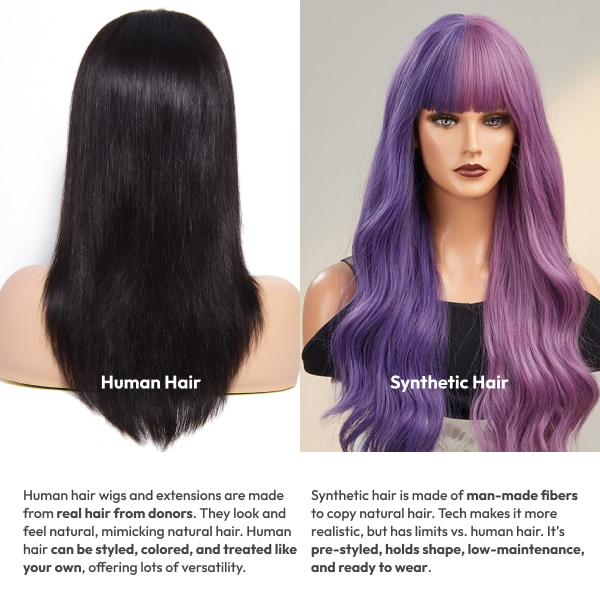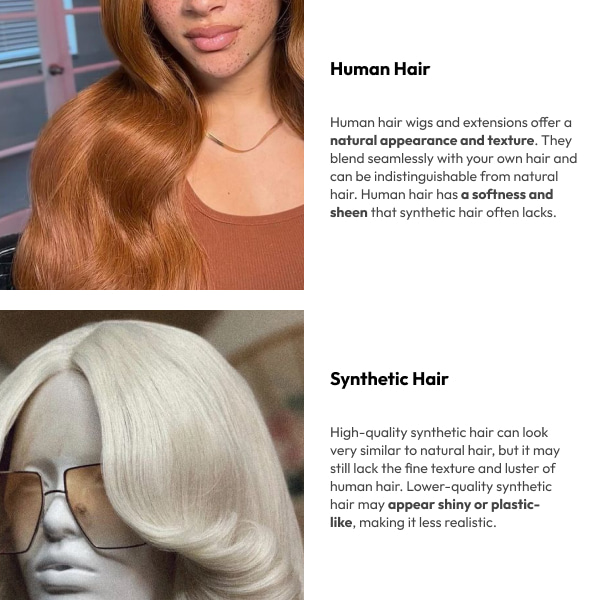




What is the difference between human hair and synthetic hair?
Introduction
Choosing between human hair and synthetic hair for wigs or hair extensions can significantly impact your styling experience and the overall look you achieve. Both types have their unique characteristics, benefits, and drawbacks. Understanding these differences will help you make an informed decision based on your needs and lifestyle. This article explores the key distinctions between human hair and synthetic hair, helping you choose the best option for your hair needs.
Human Hair vs. Synthetic Hair: An Overview
What is Human Hair?
Human hair wigs and extensions are made from real human hair collected from donors. They are known for their natural look and feel, mimicking the appearance and texture of natural hair. Human hair can be styled, colored, and treated just like your own hair, offering a high degree of versatility.
What is Synthetic Hair?
Synthetic hair is made from man-made fibers designed to replicate the appearance of natural hair. Advances in technology have allowed synthetic hair to look increasingly realistic, though it still has some limitations compared to human hair. Synthetic hair is pre-styled and holds its shape, making it low-maintenance and ready to wear out of the box.
Key Differences Between Human Hair and Synthetic Hair
Appearance and Texture
- Human Hair: Human hair wigs and extensions offer a natural appearance and texture. They blend seamlessly with your own hair and can be indistinguishable from natural hair. Human hair has a softness and sheen that synthetic hair often lacks.
- Synthetic Hair: High-quality synthetic hair can look very similar to natural hair, but it may still lack the fine texture and luster of human hair. Lower-quality synthetic hair may appear shiny or plastic-like, making it less realistic.
Styling Versatility
- Human Hair: Human hair can be styled using heat tools such as curling irons, flat irons, and blow dryers. It can also be colored, permed, and treated, providing endless styling possibilities.
- Synthetic Hair: Most synthetic hair cannot be heat-styled or chemically treated. Some heat-friendly synthetic fibers can withstand low heat, but they still do not offer the same versatility as human hair. Synthetic hair comes pre-styled and retains its shape, limiting your styling options.
Durability and Longevity
- Human Hair: With proper care, human hair wigs and extensions can last over a year. They are durable and can withstand regular styling and maintenance.
- Synthetic Hair: Synthetic hair typically has a shorter lifespan, lasting about 4 to 6 months with regular use. Its durability can be affected by exposure to heat, friction, and environmental factors.
Maintenance and Care
- Human Hair: Human hair requires regular washing, conditioning, and styling, similar to your natural hair. It may also need occasional treatments to maintain its shine and softness.
- Synthetic Hair: Synthetic hair is low-maintenance and requires less frequent washing. It retains its style even after washing and does not need styling products. However, it can be more difficult to detangle and may require specific synthetic hair care products.
Cost Considerations
- Human Hair: Human hair wigs and extensions are generally more expensive due to the quality of the hair and the labor-intensive process of collecting and preparing it.
- Synthetic Hair: Synthetic hair is more affordable and widely available. It offers a budget-friendly option for those looking for temporary or occasional wear.
Suitability for Different Needs
Human Hair
- Who It’s For: Ideal for individuals seeking a natural look and feel, with the flexibility to style and treat the hair as desired. Suitable for long-term wear and those who frequently change their hairstyle.
- Best Use: Daily wear, special occasions, and when a high degree of customization is needed.
Synthetic Hair
- Who It’s For: Perfect for those looking for a low-maintenance, affordable option. Ideal for temporary use or when a specific, consistent style is desired.
- Best Use: Occasional wear, costume use, and for individuals who prefer pre-styled, ready-to-wear hair.
Pros and Cons
Human Hair Pros
- Natural appearance and texture
- High styling versatility
- Can be colored and treated
- Durable with proper care
Human Hair Cons
- Higher cost
- Requires regular maintenance
- Can be affected by weather and humidity
Synthetic Hair Pros
- Lower cost
- Low maintenance
- Pre-styled and retains shape
- Consistent look
Synthetic Hair Cons
- Limited styling options
- Shorter lifespan
- Can appear less natural
Your questions answered
FAQs
Can synthetic hair be dyed?
No, synthetic hair cannot be dyed as the fibers do not absorb color like human hair. Attempting to dye synthetic hair can damage the fibers.
How often should I wash my human hair wig?
It’s recommended to wash your human hair wig every 7-10 wears or when it appears dirty or greasy to maintain its quality and longevity.
Can I use regular hair products on synthetic hair?
No, it’s best to use products specifically designed for synthetic hair to avoid damaging the fibers. Regular hair products can cause buildup and affect the appearance and texture of synthetic hair.
Which type of hair is better for humid climates?
Synthetic hair is generally better for humid climates as it retains its style regardless of the weather. Human hair can become frizzy or lose its style in high humidity.
How do I detangle synthetic hair?
Use a wide-tooth comb or a brush designed for synthetic hair, starting from the ends and working your way up to avoid pulling or breaking the fibers.
Is human hair worth the higher cost?
If you prioritize a natural look, styling versatility, and longevity, the higher cost of human hair can be justified. It offers a premium experience compared to synthetic hair.